Individual Reflection: Teamwork Models, Business Canvas and Structure
VerifiedAdded on 2023/06/16
|12
|2757
|494
Essay
AI Summary
This essay presents an individual reflection on teamwork and business ideas, exploring the application of the Tuckman model and Belbin's teamwork theory. It discusses the stages of team development, from forming to adjourning, and highlights the importance of communication, problem-solving, and leadership skills. The essay also reflects on the use of the business model canvas as a tool for clarifying business ideas, focusing on key activities, partners, resources, and customer segments. Furthermore, it examines the extent to which an enterprise is supported by its organizational structure, emphasizing the role of leaders in choosing the right structure to achieve organizational goals. The reflection concludes that teamwork is essential for achieving company objectives, building knowledge and skills, and fostering discipline, collaboration, and cooperation among team members. Desklib provides similar essays and resources for students.
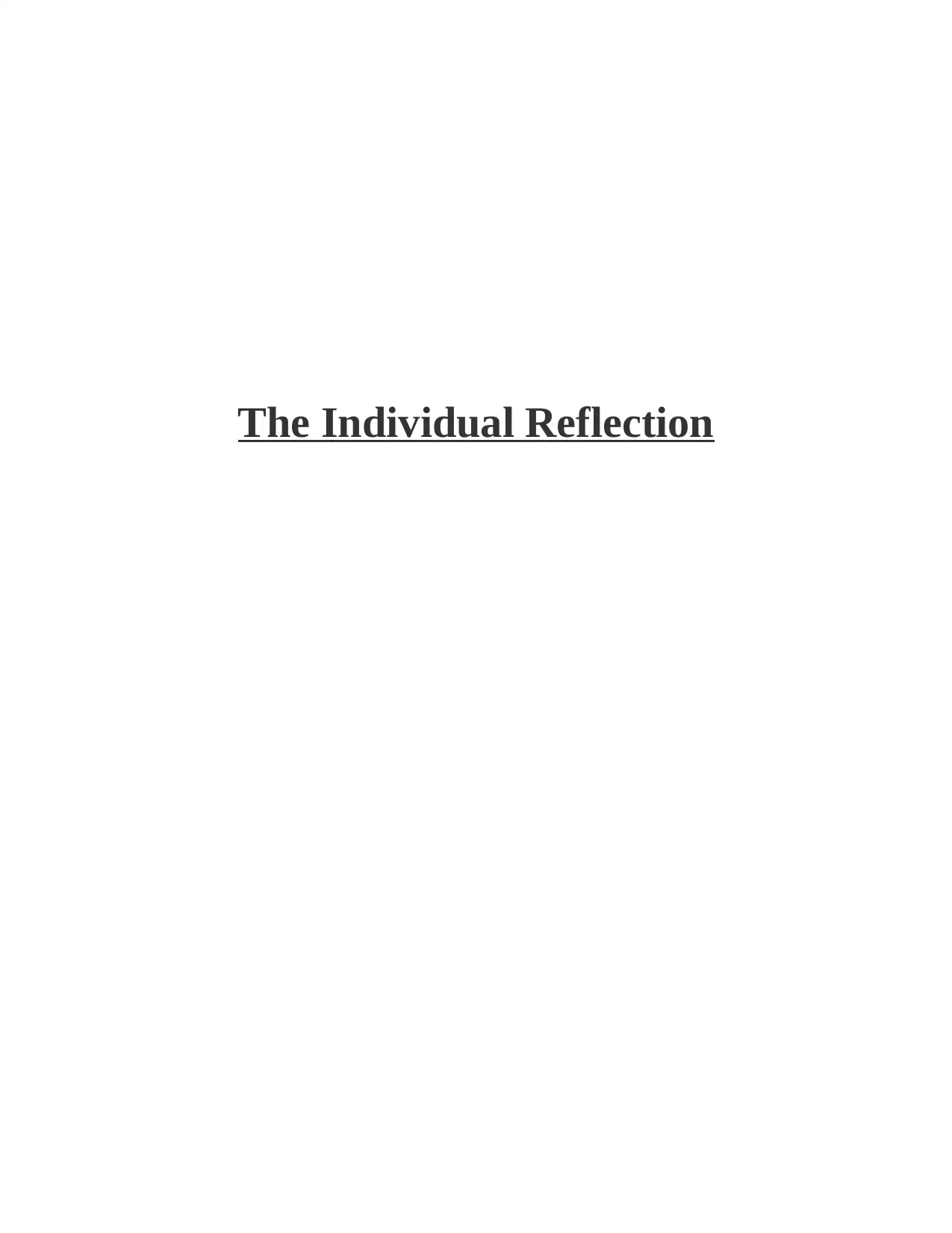
The Individual Reflection
Paraphrase This Document
Need a fresh take? Get an instant paraphrase of this document with our AI Paraphraser
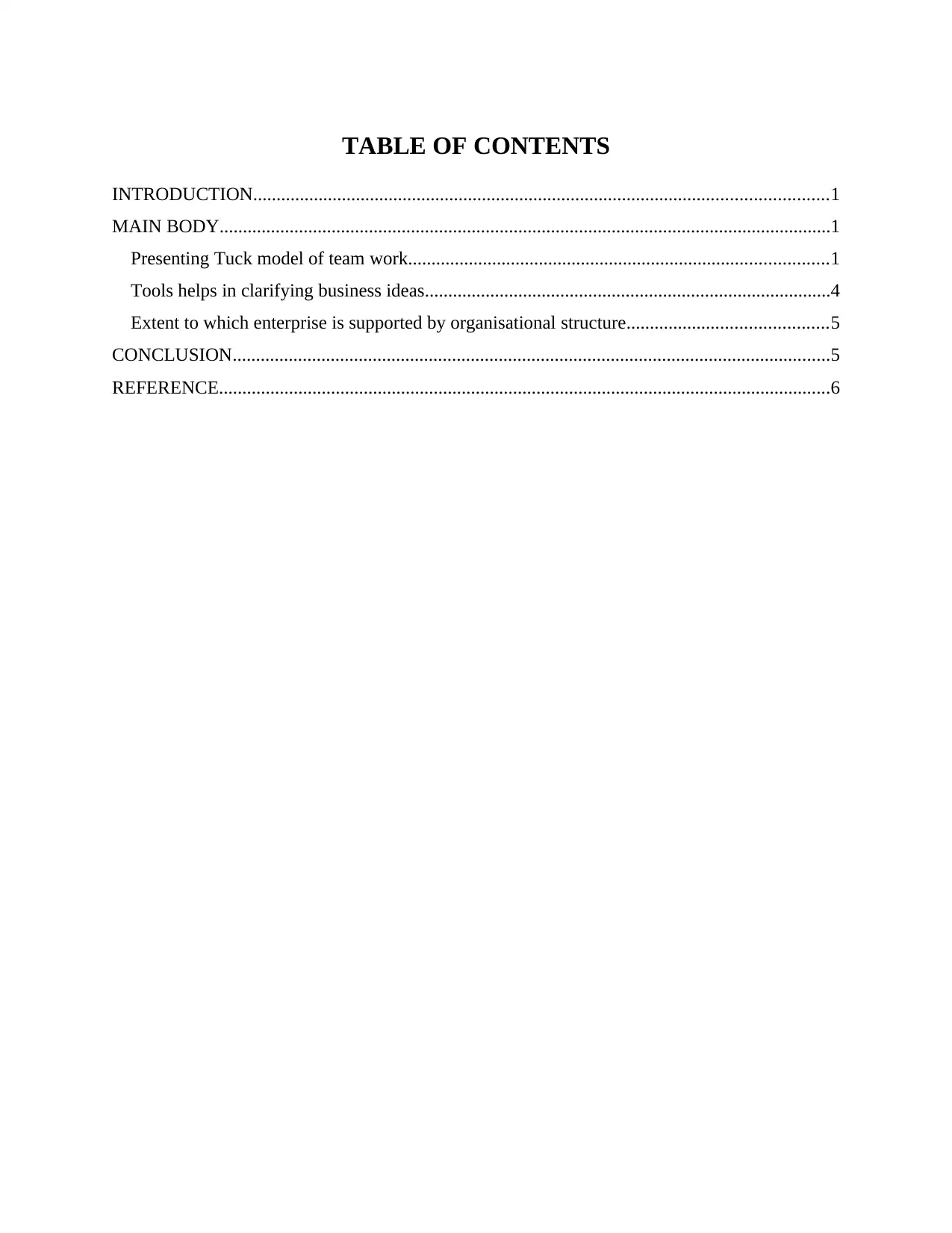
TABLE OF CONTENTS
INTRODUCTION...........................................................................................................................1
MAIN BODY...................................................................................................................................1
Presenting Tuck model of team work..........................................................................................1
Tools helps in clarifying business ideas.......................................................................................4
Extent to which enterprise is supported by organisational structure...........................................5
CONCLUSION................................................................................................................................5
REFERENCE...................................................................................................................................6
INTRODUCTION...........................................................................................................................1
MAIN BODY...................................................................................................................................1
Presenting Tuck model of team work..........................................................................................1
Tools helps in clarifying business ideas.......................................................................................4
Extent to which enterprise is supported by organisational structure...........................................5
CONCLUSION................................................................................................................................5
REFERENCE...................................................................................................................................6
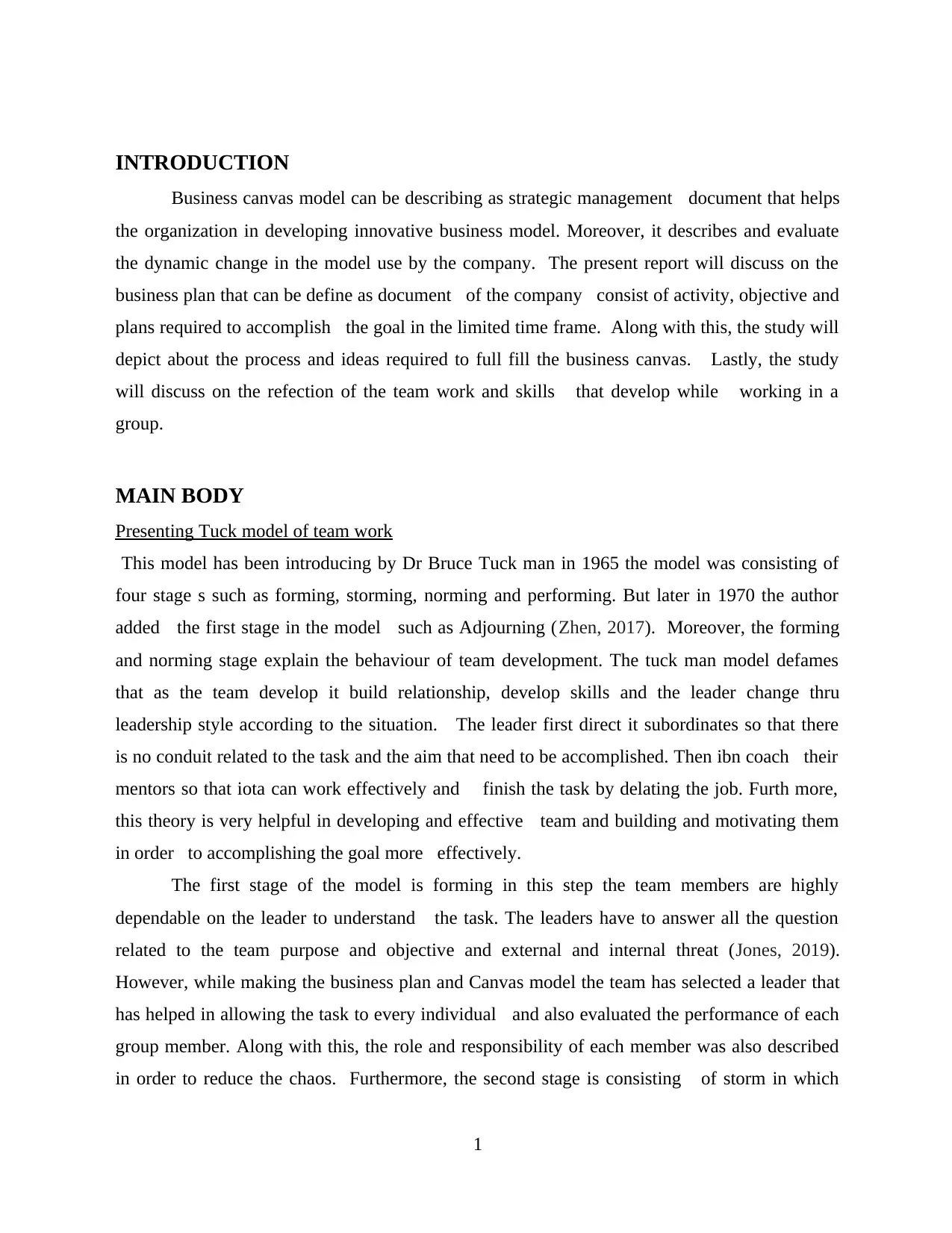
INTRODUCTION
Business canvas model can be describing as strategic management document that helps
the organization in developing innovative business model. Moreover, it describes and evaluate
the dynamic change in the model use by the company. The present report will discuss on the
business plan that can be define as document of the company consist of activity, objective and
plans required to accomplish the goal in the limited time frame. Along with this, the study will
depict about the process and ideas required to full fill the business canvas. Lastly, the study
will discuss on the refection of the team work and skills that develop while working in a
group.
MAIN BODY
Presenting Tuck model of team work
This model has been introducing by Dr Bruce Tuck man in 1965 the model was consisting of
four stage s such as forming, storming, norming and performing. But later in 1970 the author
added the first stage in the model such as Adjourning (Zhen, 2017). Moreover, the forming
and norming stage explain the behaviour of team development. The tuck man model defames
that as the team develop it build relationship, develop skills and the leader change thru
leadership style according to the situation. The leader first direct it subordinates so that there
is no conduit related to the task and the aim that need to be accomplished. Then ibn coach their
mentors so that iota can work effectively and finish the task by delating the job. Furth more,
this theory is very helpful in developing and effective team and building and motivating them
in order to accomplishing the goal more effectively.
The first stage of the model is forming in this step the team members are highly
dependable on the leader to understand the task. The leaders have to answer all the question
related to the team purpose and objective and external and internal threat (Jones, 2019).
However, while making the business plan and Canvas model the team has selected a leader that
has helped in allowing the task to every individual and also evaluated the performance of each
group member. Along with this, the role and responsibility of each member was also described
in order to reduce the chaos. Furthermore, the second stage is consisting of storm in which
1
Business canvas model can be describing as strategic management document that helps
the organization in developing innovative business model. Moreover, it describes and evaluate
the dynamic change in the model use by the company. The present report will discuss on the
business plan that can be define as document of the company consist of activity, objective and
plans required to accomplish the goal in the limited time frame. Along with this, the study will
depict about the process and ideas required to full fill the business canvas. Lastly, the study
will discuss on the refection of the team work and skills that develop while working in a
group.
MAIN BODY
Presenting Tuck model of team work
This model has been introducing by Dr Bruce Tuck man in 1965 the model was consisting of
four stage s such as forming, storming, norming and performing. But later in 1970 the author
added the first stage in the model such as Adjourning (Zhen, 2017). Moreover, the forming
and norming stage explain the behaviour of team development. The tuck man model defames
that as the team develop it build relationship, develop skills and the leader change thru
leadership style according to the situation. The leader first direct it subordinates so that there
is no conduit related to the task and the aim that need to be accomplished. Then ibn coach their
mentors so that iota can work effectively and finish the task by delating the job. Furth more,
this theory is very helpful in developing and effective team and building and motivating them
in order to accomplishing the goal more effectively.
The first stage of the model is forming in this step the team members are highly
dependable on the leader to understand the task. The leaders have to answer all the question
related to the team purpose and objective and external and internal threat (Jones, 2019).
However, while making the business plan and Canvas model the team has selected a leader that
has helped in allowing the task to every individual and also evaluated the performance of each
group member. Along with this, the role and responsibility of each member was also described
in order to reduce the chaos. Furthermore, the second stage is consisting of storm in which
1
⊘ This is a preview!⊘
Do you want full access?
Subscribe today to unlock all pages.

Trusted by 1+ million students worldwide
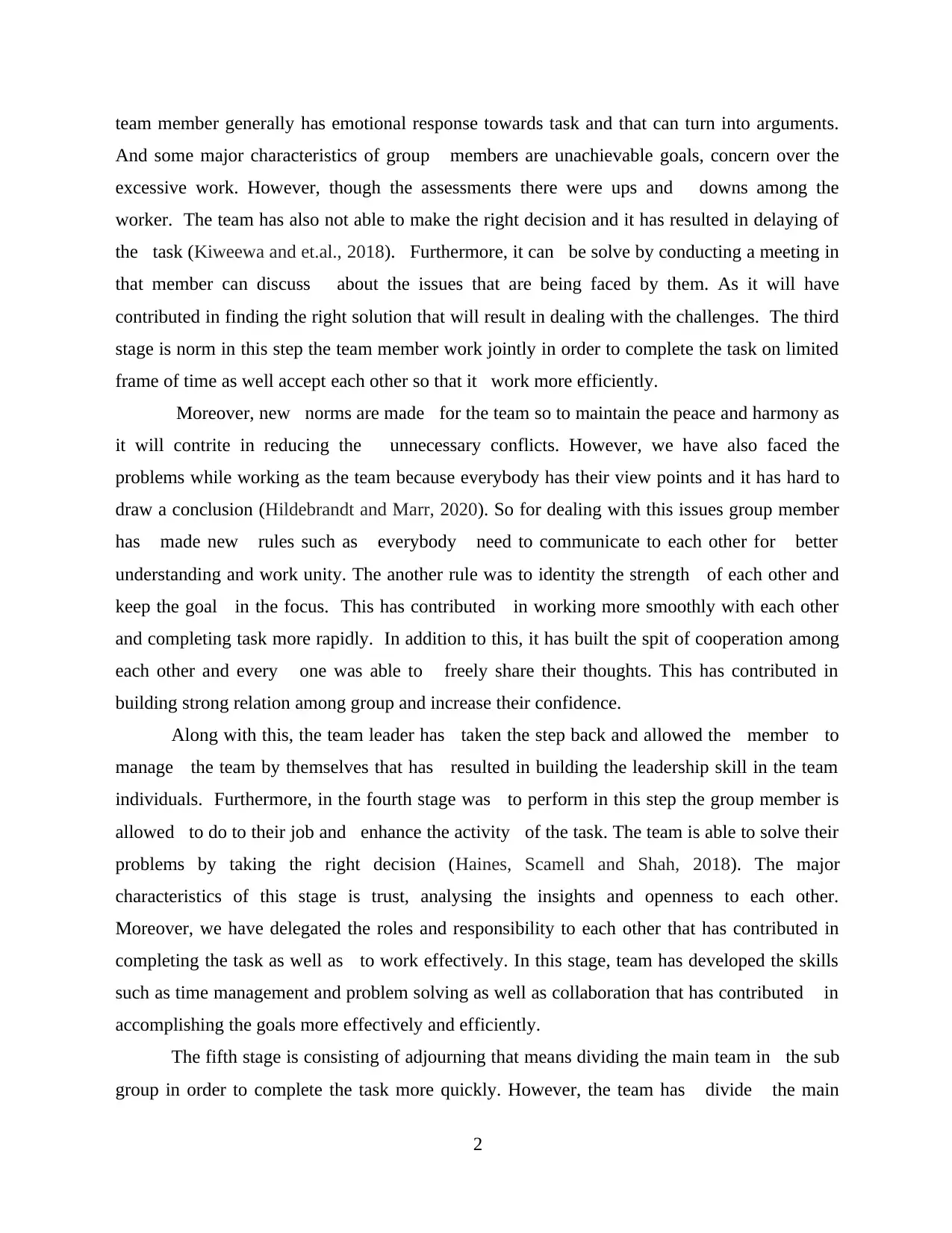
team member generally has emotional response towards task and that can turn into arguments.
And some major characteristics of group members are unachievable goals, concern over the
excessive work. However, though the assessments there were ups and downs among the
worker. The team has also not able to make the right decision and it has resulted in delaying of
the task (Kiweewa and et.al., 2018). Furthermore, it can be solve by conducting a meeting in
that member can discuss about the issues that are being faced by them. As it will have
contributed in finding the right solution that will result in dealing with the challenges. The third
stage is norm in this step the team member work jointly in order to complete the task on limited
frame of time as well accept each other so that it work more efficiently.
Moreover, new norms are made for the team so to maintain the peace and harmony as
it will contrite in reducing the unnecessary conflicts. However, we have also faced the
problems while working as the team because everybody has their view points and it has hard to
draw a conclusion (Hildebrandt and Marr, 2020). So for dealing with this issues group member
has made new rules such as everybody need to communicate to each other for better
understanding and work unity. The another rule was to identity the strength of each other and
keep the goal in the focus. This has contributed in working more smoothly with each other
and completing task more rapidly. In addition to this, it has built the spit of cooperation among
each other and every one was able to freely share their thoughts. This has contributed in
building strong relation among group and increase their confidence.
Along with this, the team leader has taken the step back and allowed the member to
manage the team by themselves that has resulted in building the leadership skill in the team
individuals. Furthermore, in the fourth stage was to perform in this step the group member is
allowed to do to their job and enhance the activity of the task. The team is able to solve their
problems by taking the right decision (Haines, Scamell and Shah, 2018). The major
characteristics of this stage is trust, analysing the insights and openness to each other.
Moreover, we have delegated the roles and responsibility to each other that has contributed in
completing the task as well as to work effectively. In this stage, team has developed the skills
such as time management and problem solving as well as collaboration that has contributed in
accomplishing the goals more effectively and efficiently.
The fifth stage is consisting of adjourning that means dividing the main team in the sub
group in order to complete the task more quickly. However, the team has divide the main
2
And some major characteristics of group members are unachievable goals, concern over the
excessive work. However, though the assessments there were ups and downs among the
worker. The team has also not able to make the right decision and it has resulted in delaying of
the task (Kiweewa and et.al., 2018). Furthermore, it can be solve by conducting a meeting in
that member can discuss about the issues that are being faced by them. As it will have
contributed in finding the right solution that will result in dealing with the challenges. The third
stage is norm in this step the team member work jointly in order to complete the task on limited
frame of time as well accept each other so that it work more efficiently.
Moreover, new norms are made for the team so to maintain the peace and harmony as
it will contrite in reducing the unnecessary conflicts. However, we have also faced the
problems while working as the team because everybody has their view points and it has hard to
draw a conclusion (Hildebrandt and Marr, 2020). So for dealing with this issues group member
has made new rules such as everybody need to communicate to each other for better
understanding and work unity. The another rule was to identity the strength of each other and
keep the goal in the focus. This has contributed in working more smoothly with each other
and completing task more rapidly. In addition to this, it has built the spit of cooperation among
each other and every one was able to freely share their thoughts. This has contributed in
building strong relation among group and increase their confidence.
Along with this, the team leader has taken the step back and allowed the member to
manage the team by themselves that has resulted in building the leadership skill in the team
individuals. Furthermore, in the fourth stage was to perform in this step the group member is
allowed to do to their job and enhance the activity of the task. The team is able to solve their
problems by taking the right decision (Haines, Scamell and Shah, 2018). The major
characteristics of this stage is trust, analysing the insights and openness to each other.
Moreover, we have delegated the roles and responsibility to each other that has contributed in
completing the task as well as to work effectively. In this stage, team has developed the skills
such as time management and problem solving as well as collaboration that has contributed in
accomplishing the goals more effectively and efficiently.
The fifth stage is consisting of adjourning that means dividing the main team in the sub
group in order to complete the task more quickly. However, the team has divide the main
2
Paraphrase This Document
Need a fresh take? Get an instant paraphrase of this document with our AI Paraphraser
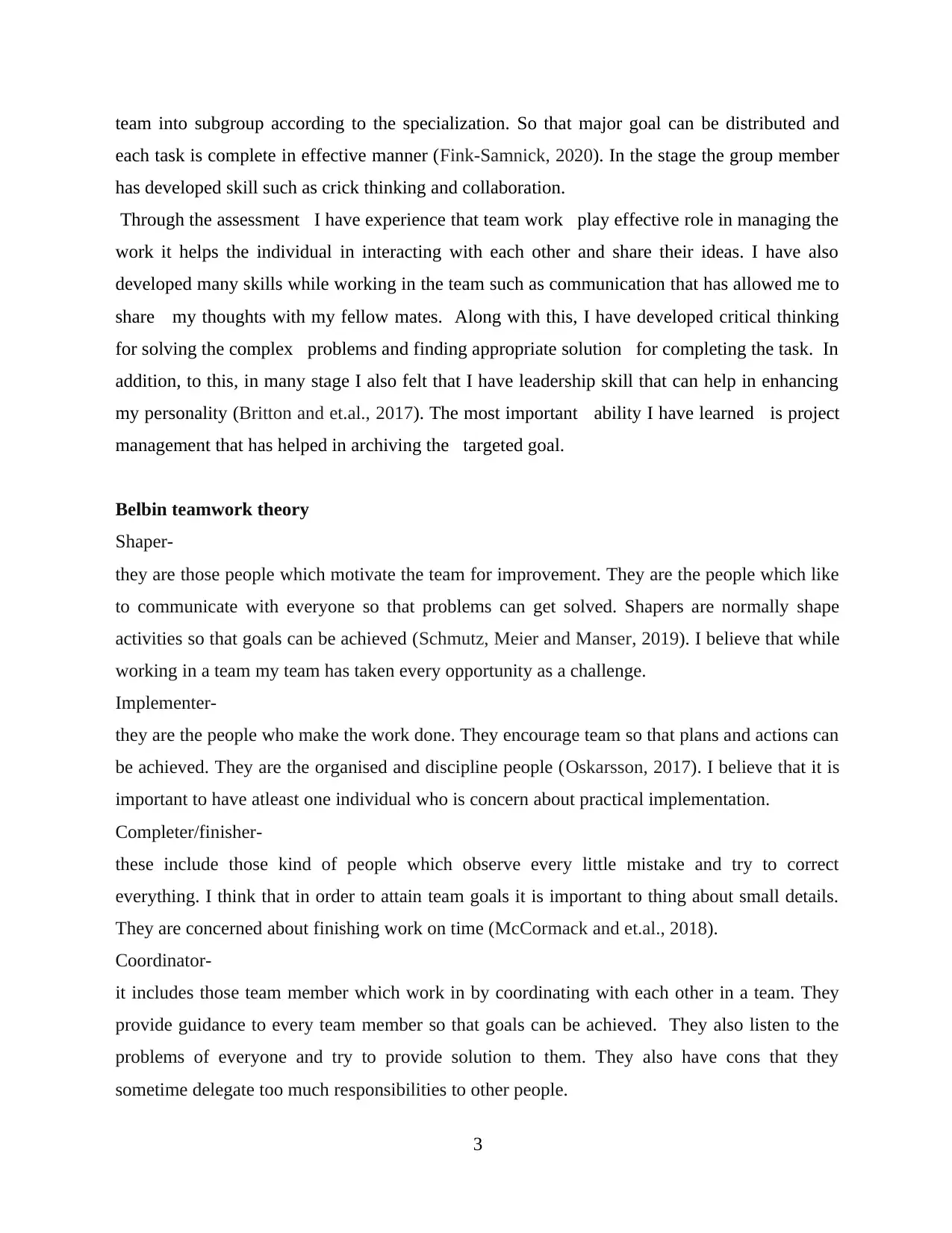
team into subgroup according to the specialization. So that major goal can be distributed and
each task is complete in effective manner (Fink-Samnick, 2020). In the stage the group member
has developed skill such as crick thinking and collaboration.
Through the assessment I have experience that team work play effective role in managing the
work it helps the individual in interacting with each other and share their ideas. I have also
developed many skills while working in the team such as communication that has allowed me to
share my thoughts with my fellow mates. Along with this, I have developed critical thinking
for solving the complex problems and finding appropriate solution for completing the task. In
addition, to this, in many stage I also felt that I have leadership skill that can help in enhancing
my personality (Britton and et.al., 2017). The most important ability I have learned is project
management that has helped in archiving the targeted goal.
Belbin teamwork theory
Shaper-
they are those people which motivate the team for improvement. They are the people which like
to communicate with everyone so that problems can get solved. Shapers are normally shape
activities so that goals can be achieved (Schmutz, Meier and Manser, 2019). I believe that while
working in a team my team has taken every opportunity as a challenge.
Implementer-
they are the people who make the work done. They encourage team so that plans and actions can
be achieved. They are the organised and discipline people (Oskarsson, 2017). I believe that it is
important to have atleast one individual who is concern about practical implementation.
Completer/finisher-
these include those kind of people which observe every little mistake and try to correct
everything. I think that in order to attain team goals it is important to thing about small details.
They are concerned about finishing work on time (McCormack and et.al., 2018).
Coordinator-
it includes those team member which work in by coordinating with each other in a team. They
provide guidance to every team member so that goals can be achieved. They also listen to the
problems of everyone and try to provide solution to them. They also have cons that they
sometime delegate too much responsibilities to other people.
3
each task is complete in effective manner (Fink-Samnick, 2020). In the stage the group member
has developed skill such as crick thinking and collaboration.
Through the assessment I have experience that team work play effective role in managing the
work it helps the individual in interacting with each other and share their ideas. I have also
developed many skills while working in the team such as communication that has allowed me to
share my thoughts with my fellow mates. Along with this, I have developed critical thinking
for solving the complex problems and finding appropriate solution for completing the task. In
addition, to this, in many stage I also felt that I have leadership skill that can help in enhancing
my personality (Britton and et.al., 2017). The most important ability I have learned is project
management that has helped in archiving the targeted goal.
Belbin teamwork theory
Shaper-
they are those people which motivate the team for improvement. They are the people which like
to communicate with everyone so that problems can get solved. Shapers are normally shape
activities so that goals can be achieved (Schmutz, Meier and Manser, 2019). I believe that while
working in a team my team has taken every opportunity as a challenge.
Implementer-
they are the people who make the work done. They encourage team so that plans and actions can
be achieved. They are the organised and discipline people (Oskarsson, 2017). I believe that it is
important to have atleast one individual who is concern about practical implementation.
Completer/finisher-
these include those kind of people which observe every little mistake and try to correct
everything. I think that in order to attain team goals it is important to thing about small details.
They are concerned about finishing work on time (McCormack and et.al., 2018).
Coordinator-
it includes those team member which work in by coordinating with each other in a team. They
provide guidance to every team member so that goals can be achieved. They also listen to the
problems of everyone and try to provide solution to them. They also have cons that they
sometime delegate too much responsibilities to other people.
3
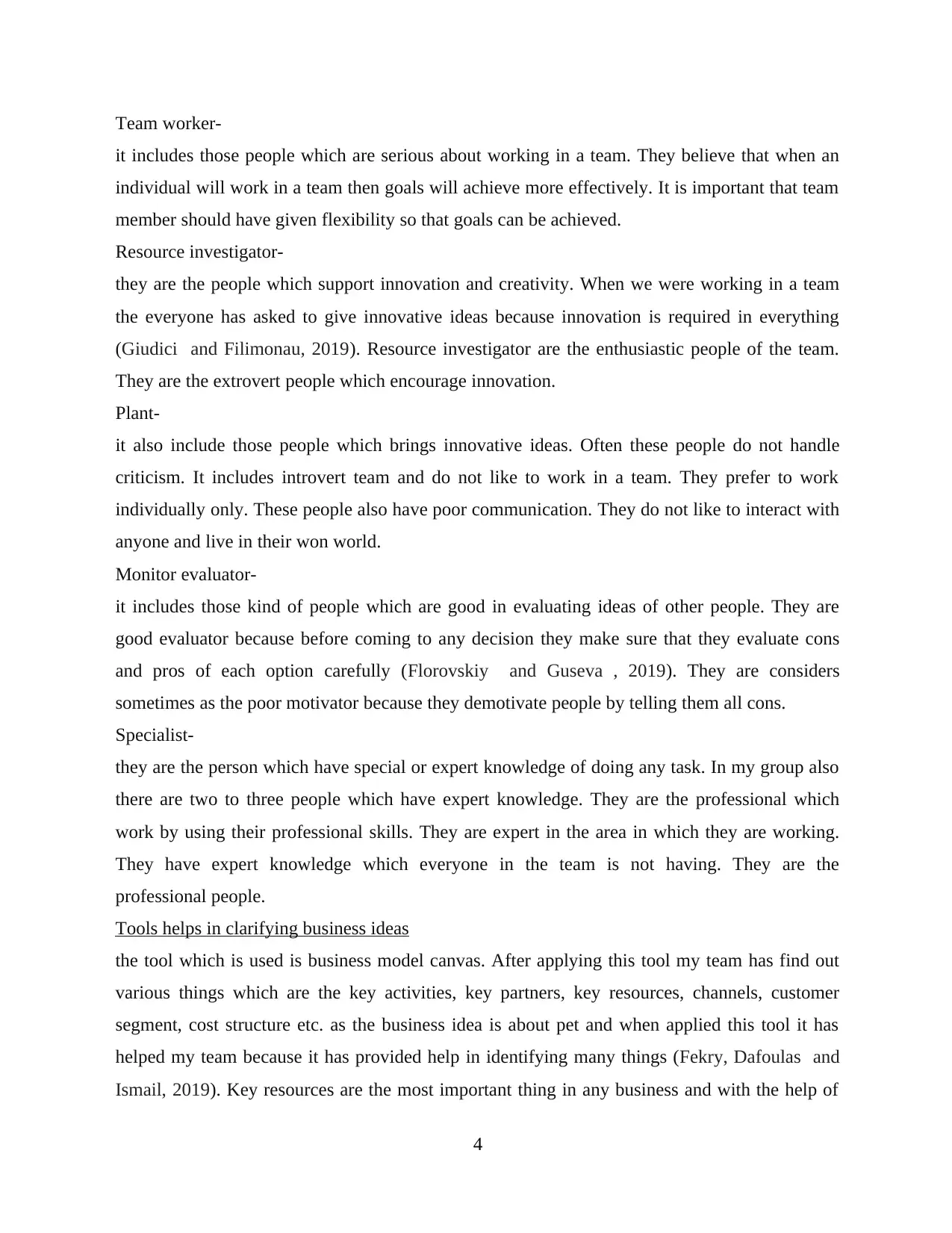
Team worker-
it includes those people which are serious about working in a team. They believe that when an
individual will work in a team then goals will achieve more effectively. It is important that team
member should have given flexibility so that goals can be achieved.
Resource investigator-
they are the people which support innovation and creativity. When we were working in a team
the everyone has asked to give innovative ideas because innovation is required in everything
(Giudici and Filimonau, 2019). Resource investigator are the enthusiastic people of the team.
They are the extrovert people which encourage innovation.
Plant-
it also include those people which brings innovative ideas. Often these people do not handle
criticism. It includes introvert team and do not like to work in a team. They prefer to work
individually only. These people also have poor communication. They do not like to interact with
anyone and live in their won world.
Monitor evaluator-
it includes those kind of people which are good in evaluating ideas of other people. They are
good evaluator because before coming to any decision they make sure that they evaluate cons
and pros of each option carefully (Florovskiy and Guseva , 2019). They are considers
sometimes as the poor motivator because they demotivate people by telling them all cons.
Specialist-
they are the person which have special or expert knowledge of doing any task. In my group also
there are two to three people which have expert knowledge. They are the professional which
work by using their professional skills. They are expert in the area in which they are working.
They have expert knowledge which everyone in the team is not having. They are the
professional people.
Tools helps in clarifying business ideas
the tool which is used is business model canvas. After applying this tool my team has find out
various things which are the key activities, key partners, key resources, channels, customer
segment, cost structure etc. as the business idea is about pet and when applied this tool it has
helped my team because it has provided help in identifying many things (Fekry, Dafoulas and
Ismail, 2019). Key resources are the most important thing in any business and with the help of
4
it includes those people which are serious about working in a team. They believe that when an
individual will work in a team then goals will achieve more effectively. It is important that team
member should have given flexibility so that goals can be achieved.
Resource investigator-
they are the people which support innovation and creativity. When we were working in a team
the everyone has asked to give innovative ideas because innovation is required in everything
(Giudici and Filimonau, 2019). Resource investigator are the enthusiastic people of the team.
They are the extrovert people which encourage innovation.
Plant-
it also include those people which brings innovative ideas. Often these people do not handle
criticism. It includes introvert team and do not like to work in a team. They prefer to work
individually only. These people also have poor communication. They do not like to interact with
anyone and live in their won world.
Monitor evaluator-
it includes those kind of people which are good in evaluating ideas of other people. They are
good evaluator because before coming to any decision they make sure that they evaluate cons
and pros of each option carefully (Florovskiy and Guseva , 2019). They are considers
sometimes as the poor motivator because they demotivate people by telling them all cons.
Specialist-
they are the person which have special or expert knowledge of doing any task. In my group also
there are two to three people which have expert knowledge. They are the professional which
work by using their professional skills. They are expert in the area in which they are working.
They have expert knowledge which everyone in the team is not having. They are the
professional people.
Tools helps in clarifying business ideas
the tool which is used is business model canvas. After applying this tool my team has find out
various things which are the key activities, key partners, key resources, channels, customer
segment, cost structure etc. as the business idea is about pet and when applied this tool it has
helped my team because it has provided help in identifying many things (Fekry, Dafoulas and
Ismail, 2019). Key resources are the most important thing in any business and with the help of
4
⊘ This is a preview!⊘
Do you want full access?
Subscribe today to unlock all pages.

Trusted by 1+ million students worldwide
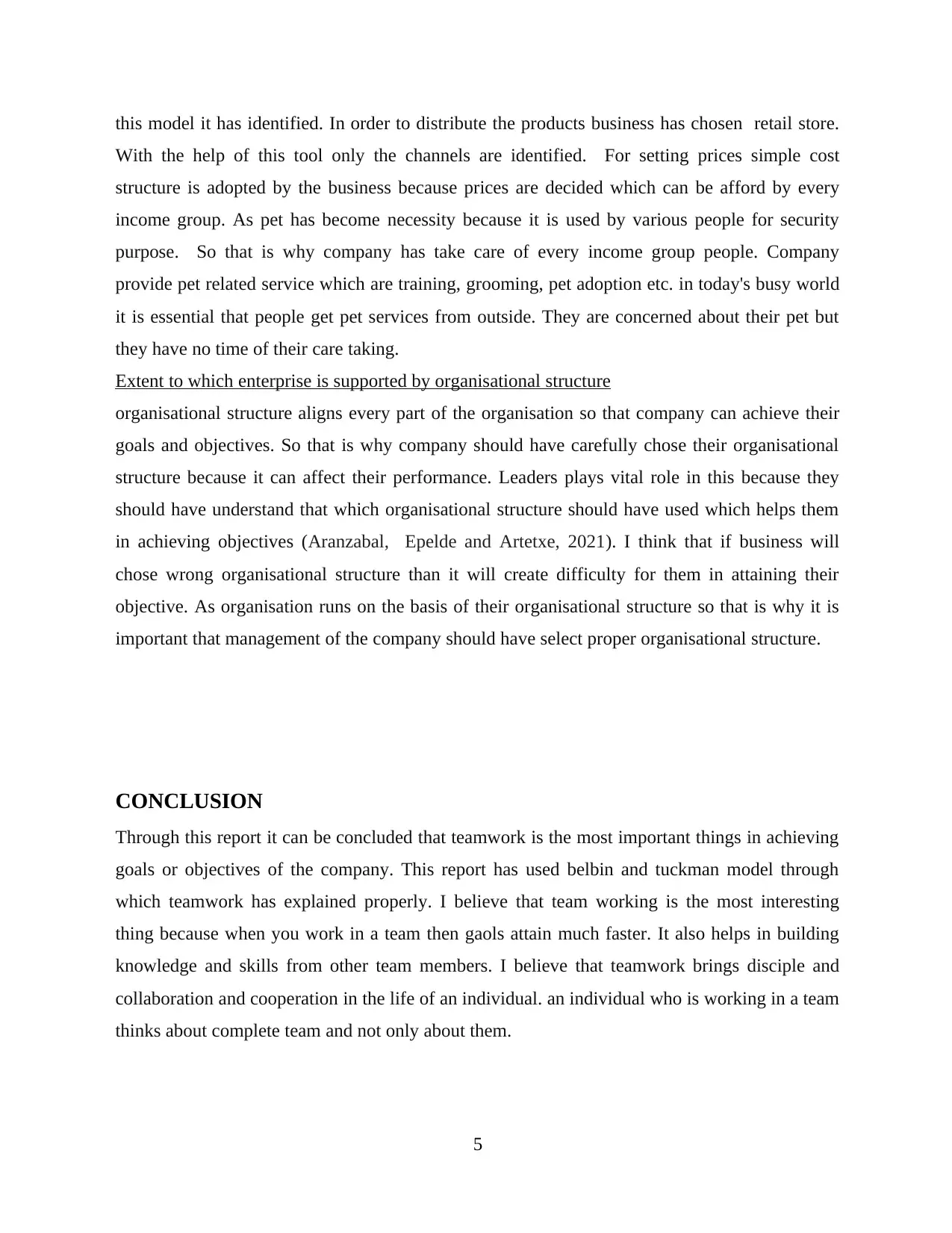
this model it has identified. In order to distribute the products business has chosen retail store.
With the help of this tool only the channels are identified. For setting prices simple cost
structure is adopted by the business because prices are decided which can be afford by every
income group. As pet has become necessity because it is used by various people for security
purpose. So that is why company has take care of every income group people. Company
provide pet related service which are training, grooming, pet adoption etc. in today's busy world
it is essential that people get pet services from outside. They are concerned about their pet but
they have no time of their care taking.
Extent to which enterprise is supported by organisational structure
organisational structure aligns every part of the organisation so that company can achieve their
goals and objectives. So that is why company should have carefully chose their organisational
structure because it can affect their performance. Leaders plays vital role in this because they
should have understand that which organisational structure should have used which helps them
in achieving objectives (Aranzabal, Epelde and Artetxe, 2021). I think that if business will
chose wrong organisational structure than it will create difficulty for them in attaining their
objective. As organisation runs on the basis of their organisational structure so that is why it is
important that management of the company should have select proper organisational structure.
CONCLUSION
Through this report it can be concluded that teamwork is the most important things in achieving
goals or objectives of the company. This report has used belbin and tuckman model through
which teamwork has explained properly. I believe that team working is the most interesting
thing because when you work in a team then gaols attain much faster. It also helps in building
knowledge and skills from other team members. I believe that teamwork brings disciple and
collaboration and cooperation in the life of an individual. an individual who is working in a team
thinks about complete team and not only about them.
5
With the help of this tool only the channels are identified. For setting prices simple cost
structure is adopted by the business because prices are decided which can be afford by every
income group. As pet has become necessity because it is used by various people for security
purpose. So that is why company has take care of every income group people. Company
provide pet related service which are training, grooming, pet adoption etc. in today's busy world
it is essential that people get pet services from outside. They are concerned about their pet but
they have no time of their care taking.
Extent to which enterprise is supported by organisational structure
organisational structure aligns every part of the organisation so that company can achieve their
goals and objectives. So that is why company should have carefully chose their organisational
structure because it can affect their performance. Leaders plays vital role in this because they
should have understand that which organisational structure should have used which helps them
in achieving objectives (Aranzabal, Epelde and Artetxe, 2021). I think that if business will
chose wrong organisational structure than it will create difficulty for them in attaining their
objective. As organisation runs on the basis of their organisational structure so that is why it is
important that management of the company should have select proper organisational structure.
CONCLUSION
Through this report it can be concluded that teamwork is the most important things in achieving
goals or objectives of the company. This report has used belbin and tuckman model through
which teamwork has explained properly. I believe that team working is the most interesting
thing because when you work in a team then gaols attain much faster. It also helps in building
knowledge and skills from other team members. I believe that teamwork brings disciple and
collaboration and cooperation in the life of an individual. an individual who is working in a team
thinks about complete team and not only about them.
5
Paraphrase This Document
Need a fresh take? Get an instant paraphrase of this document with our AI Paraphraser
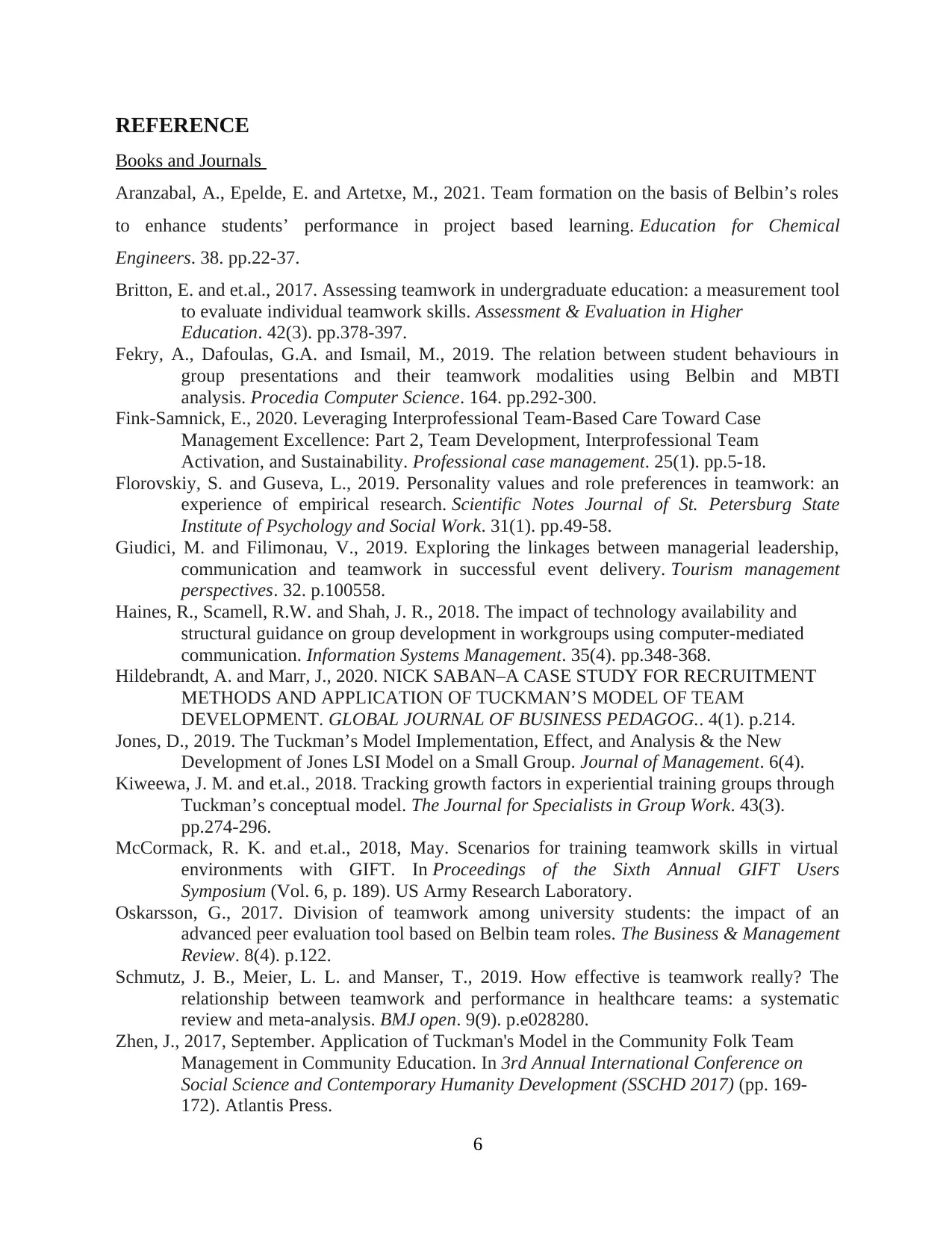
REFERENCE
Books and Journals
Aranzabal, A., Epelde, E. and Artetxe, M., 2021. Team formation on the basis of Belbin’s roles
to enhance students’ performance in project based learning. Education for Chemical
Engineers. 38. pp.22-37.
Britton, E. and et.al., 2017. Assessing teamwork in undergraduate education: a measurement tool
to evaluate individual teamwork skills. Assessment & Evaluation in Higher
Education. 42(3). pp.378-397.
Fekry, A., Dafoulas, G.A. and Ismail, M., 2019. The relation between student behaviours in
group presentations and their teamwork modalities using Belbin and MBTI
analysis. Procedia Computer Science. 164. pp.292-300.
Fink-Samnick, E., 2020. Leveraging Interprofessional Team-Based Care Toward Case
Management Excellence: Part 2, Team Development, Interprofessional Team
Activation, and Sustainability. Professional case management. 25(1). pp.5-18.
Florovskiy, S. and Guseva, L., 2019. Personality values and role preferences in teamwork: an
experience of empirical research. Scientific Notes Journal of St. Petersburg State
Institute of Psychology and Social Work. 31(1). pp.49-58.
Giudici, M. and Filimonau, V., 2019. Exploring the linkages between managerial leadership,
communication and teamwork in successful event delivery. Tourism management
perspectives. 32. p.100558.
Haines, R., Scamell, R.W. and Shah, J. R., 2018. The impact of technology availability and
structural guidance on group development in workgroups using computer-mediated
communication. Information Systems Management. 35(4). pp.348-368.
Hildebrandt, A. and Marr, J., 2020. NICK SABAN–A CASE STUDY FOR RECRUITMENT
METHODS AND APPLICATION OF TUCKMAN’S MODEL OF TEAM
DEVELOPMENT. GLOBAL JOURNAL OF BUSINESS PEDAGOG.. 4(1). p.214.
Jones, D., 2019. The Tuckman’s Model Implementation, Effect, and Analysis & the New
Development of Jones LSI Model on a Small Group. Journal of Management. 6(4).
Kiweewa, J. M. and et.al., 2018. Tracking growth factors in experiential training groups through
Tuckman’s conceptual model. The Journal for Specialists in Group Work. 43(3).
pp.274-296.
McCormack, R. K. and et.al., 2018, May. Scenarios for training teamwork skills in virtual
environments with GIFT. In Proceedings of the Sixth Annual GIFT Users
Symposium (Vol. 6, p. 189). US Army Research Laboratory.
Oskarsson, G., 2017. Division of teamwork among university students: the impact of an
advanced peer evaluation tool based on Belbin team roles. The Business & Management
Review. 8(4). p.122.
Schmutz, J. B., Meier, L. L. and Manser, T., 2019. How effective is teamwork really? The
relationship between teamwork and performance in healthcare teams: a systematic
review and meta-analysis. BMJ open. 9(9). p.e028280.
Zhen, J., 2017, September. Application of Tuckman's Model in the Community Folk Team
Management in Community Education. In 3rd Annual International Conference on
Social Science and Contemporary Humanity Development (SSCHD 2017) (pp. 169-
172). Atlantis Press.
6
Books and Journals
Aranzabal, A., Epelde, E. and Artetxe, M., 2021. Team formation on the basis of Belbin’s roles
to enhance students’ performance in project based learning. Education for Chemical
Engineers. 38. pp.22-37.
Britton, E. and et.al., 2017. Assessing teamwork in undergraduate education: a measurement tool
to evaluate individual teamwork skills. Assessment & Evaluation in Higher
Education. 42(3). pp.378-397.
Fekry, A., Dafoulas, G.A. and Ismail, M., 2019. The relation between student behaviours in
group presentations and their teamwork modalities using Belbin and MBTI
analysis. Procedia Computer Science. 164. pp.292-300.
Fink-Samnick, E., 2020. Leveraging Interprofessional Team-Based Care Toward Case
Management Excellence: Part 2, Team Development, Interprofessional Team
Activation, and Sustainability. Professional case management. 25(1). pp.5-18.
Florovskiy, S. and Guseva, L., 2019. Personality values and role preferences in teamwork: an
experience of empirical research. Scientific Notes Journal of St. Petersburg State
Institute of Psychology and Social Work. 31(1). pp.49-58.
Giudici, M. and Filimonau, V., 2019. Exploring the linkages between managerial leadership,
communication and teamwork in successful event delivery. Tourism management
perspectives. 32. p.100558.
Haines, R., Scamell, R.W. and Shah, J. R., 2018. The impact of technology availability and
structural guidance on group development in workgroups using computer-mediated
communication. Information Systems Management. 35(4). pp.348-368.
Hildebrandt, A. and Marr, J., 2020. NICK SABAN–A CASE STUDY FOR RECRUITMENT
METHODS AND APPLICATION OF TUCKMAN’S MODEL OF TEAM
DEVELOPMENT. GLOBAL JOURNAL OF BUSINESS PEDAGOG.. 4(1). p.214.
Jones, D., 2019. The Tuckman’s Model Implementation, Effect, and Analysis & the New
Development of Jones LSI Model on a Small Group. Journal of Management. 6(4).
Kiweewa, J. M. and et.al., 2018. Tracking growth factors in experiential training groups through
Tuckman’s conceptual model. The Journal for Specialists in Group Work. 43(3).
pp.274-296.
McCormack, R. K. and et.al., 2018, May. Scenarios for training teamwork skills in virtual
environments with GIFT. In Proceedings of the Sixth Annual GIFT Users
Symposium (Vol. 6, p. 189). US Army Research Laboratory.
Oskarsson, G., 2017. Division of teamwork among university students: the impact of an
advanced peer evaluation tool based on Belbin team roles. The Business & Management
Review. 8(4). p.122.
Schmutz, J. B., Meier, L. L. and Manser, T., 2019. How effective is teamwork really? The
relationship between teamwork and performance in healthcare teams: a systematic
review and meta-analysis. BMJ open. 9(9). p.e028280.
Zhen, J., 2017, September. Application of Tuckman's Model in the Community Folk Team
Management in Community Education. In 3rd Annual International Conference on
Social Science and Contemporary Humanity Development (SSCHD 2017) (pp. 169-
172). Atlantis Press.
6

7
⊘ This is a preview!⊘
Do you want full access?
Subscribe today to unlock all pages.

Trusted by 1+ million students worldwide

8
Paraphrase This Document
Need a fresh take? Get an instant paraphrase of this document with our AI Paraphraser

9

10
⊘ This is a preview!⊘
Do you want full access?
Subscribe today to unlock all pages.

Trusted by 1+ million students worldwide
1 out of 12
Related Documents
Your All-in-One AI-Powered Toolkit for Academic Success.
+13062052269
info@desklib.com
Available 24*7 on WhatsApp / Email
![[object Object]](/_next/static/media/star-bottom.7253800d.svg)
Unlock your academic potential
Copyright © 2020–2025 A2Z Services. All Rights Reserved. Developed and managed by ZUCOL.





